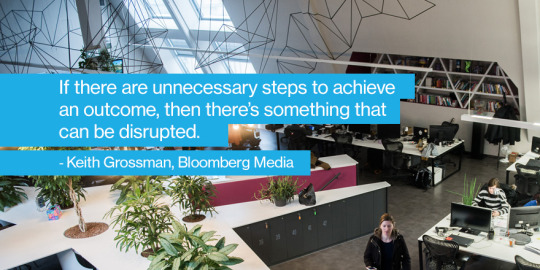April 15, 2016
As Facebook unveiled what could be the next communications revolution at its annual developer conference this week in San Francisco, conversation among the marketers gathered in New York for ClickZ Live’s digital strategy conference turned to disruption. How can brands – especially those whose legacy is offline – successfully identify and respond to new technologies in ways that allow them to keep customer attention?
Bloomberg Media’s U.S. Head of Sales Grossman joined a panel that included top executives from WeWork and hired.com to answer just that question. Often, the first step is simply figuring out what’s ripe for disruption – and which trends are most critical for your organization. “If there are unnecessary steps to achieve an outcome, then there’s something that can be disrupted,” Grossman said. “Businesses are getting bigger, better, faster,” but this means there’s a need to prioritize opportunities and “measure what you can and can’t do.”

One great lesson for Grossman comes from a favorite book: bestseller “The Innovator’s Dilemma,” by Harvard Business School prof Clayton Christensen. “It’s really hard to look at something that’s failing and decide when it’s time to move on. What businesses need to do is identify the trends they want to move on, decide if they want to be first or if they want to be second. They need to decide which trends they can’t deny – and recognize the trends they want to get ahead of.” To do that, brands also must plan for action: “it’s important to make sure you have the right resources in place before you dive in,” Grossman said.
He illustrated this point with some concrete examples: “For us, viewability is a trend you can’t deny or escape – and since it affects everyone today equally, we put all our resources into it to get ahead of it. Ad blocking impacts our landscape, but it’s not affecting everyone evenly. Thus, we don’t have to be the first to get ahead of that one; others have to confront it first and we can learn from their approaches without having to make the same investments.”

Concentrating on how your consumers are thinking and behaving is the best guide to determining where to put your organization’s focus. “It’s really sexy to talk about ‘the death of’ certain trends. But the reality is, things don’t die – they splinter, so it’s important to think about how things work together and feed into each other. No one is a digital expert; digital transcends all platforms. So businesses should be thinking about: how are consumers interacting with my brand? Can they interact by viewing? Listening? Reading?”
That’s especially important in the digital age, where consumers have more choices than ever. Grossman noted: “Consumers have to decide which brands they trust, and that’s who they will keep going back to, regardless of channel or platform.”
Good data can also help businesses set priorities and understand consumer wishes – both in the present and in the future. And the best news for businesses might be that data is only going to get better. “Our industry is at an incredible moment in time,” Grossman said. “We are really at the rudimentary beginning stage for data. The tools and capabilities that exist now are just barely scraping the surface – there’s a lot more to come in the future.”
Read next: Rethinking digital video for business audiences
– Jen Robinson | April 4, 2016